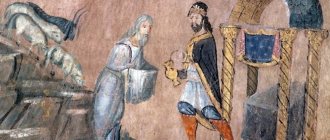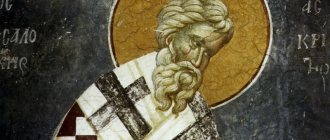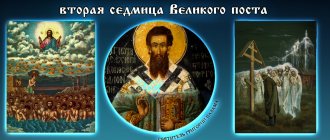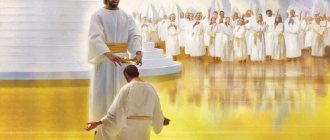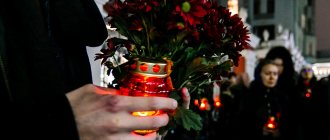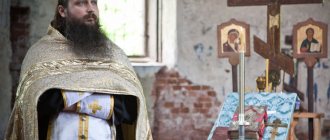In the fifth week of Great Lent, the Church remembers the Venerable Mary of Egypt. The Venerable Mother Mary is known for her unparalleled repentance. It was so deep that the former sinner not only changed her lifestyle, but until the end of her days she fasted, prayed and bitterly repented of her past life, full of filth and sin. The Lord Jesus Christ not only mercifully accepted the repentance of the harlot, but restored her damaged nature and comforted her with the abundant gifts of the Holy Spirit. Therefore, on the 5th week of Lent, the Church calls on sinners - change your life through repentance, the Lord will give you strength, forgive and soothe the pain from the wounds of sin.
Mariino standing
The peculiarity of this week is that on Thursday at Matins (usually this service is performed on Wednesday evening) the entire penitential canon of St. Andrew of Crete and the life of St. Mary of Egypt are read. In the fifth week of Great Lent, the Church teaches that there is no need to despair about one’s sinfulness, citing as an example the Venerable Mary of Egypt, who by the power of repentance rose from the abyss of sin to an equal state with the angels. Matins on Wednesday of the fifth week is called Mary's standing - standing in faith, in the fight against sin, in repentance. Every Christian who desires salvation should stand like the Venerable Mary.
The Life of Mary of Egypt was written by the Patriarch of Jerusalem, Saint Sophronius. The saint lived in the 5th century, at the age of 12 she left her parents' home and led an ungodly life out of love for sin. Together with the pilgrims, she visited the Holy Land, continuing to sin along the way and involve others in sin. Maria and everyone went to the Church of the Resurrection of Christ, but could not enter inside - an invisible wall blocked her way.
The stricken sinner thought for the first time about her wicked life. The burning shame for the sins he had committed led to a deep feeling of repentance. Mary of Egypt spent forty years in the desert, deprived of rest, food, clothing and constantly prayed to God for mercy. Before Mary's death, God brought an ascetic, Elder Zosima, into the desert. Zosima learned about the feat of the venerable desert dweller and gave her communion. After this, the days of earthly life ended for Mary. Elder Zosima buried her body, which remained incorrupt, a year later, when he again came to the desert where the saint labored. Thus, the Lord glorified the wondrous ascetic and gave us instructions in true repentance.
Using the example of Mary of Egypt, the Church shows how merciful the Lord is to sinners who want to correct their sinful lives.
They pray to the Venerable Mary of Egypt for deliverance from fornication, strengthening in faith and resistance to sin.
"Ogonyok"
Garlic
“...Since the fall I have been preparing the appetizer “Ogonyok” from horseradish and garlic, which we also call horseradish. I don’t boil vegetables and don’t seal jars so that all the vitamins are preserved. For 2 kg of tomatoes I take about 0.5 kg of horseradish, 400 g of garlic, 4 tbsp. spoons of 9% vinegar, 6 tbsp. spoons of salt.
I chop the prepared vegetables using a blender (you can use a meat grinder or food processor), add salt, put them in jars, add a little vinegar to each and put them in the refrigerator. On days of dry eating, I use the appetizer as a basis for preparing salads.
For example, I prepare salads from carrots (grated carrots and Ogonyok), fresh cabbage (red or white cabbage, carrots, greens, Ogonyok) and radishes (radish, apples, carrots, onions, Ogonyok). Horseradish can be added in small quantities, because not everyone can eat spicy dishes.”
Horseradish appetizer is a seasoning that many people love and appreciate.
And not only for its specific taste, but also for its unique medicinal properties. Everyone knows that horseradish and garlic are the best remedies for colds and infections, as well as a preventive “medicine” during a flu epidemic.
Horseradish
Horseradish (especially the root) contains a large amount of ascorbic acid, fiber, essential mustard oil, calcium, copper, phosphorus, as well as the unique substance lysozyme, which fights bacteria, and sinigrin, which increases appetite and improves metabolism.
Garlic contains phytoncides, essential oils, ascorbic acid, B vitamins, inulin, and trace elements selenium and germanium. Selenium is a very effective antioxidant. It protects the body from genetic mutations. Germanium, together with selenium and vitamins, strengthens the body and stimulates the immune system not only to fight bacteria, viruses, protozoa and fungi, but also tumors: it prevents the appearance of metastases and has an analgesic effect.
Garlic, like onions, contains allicin, which gives it special power: it fights infections and helps you recover faster, and has the ability to thin sputum, which is important in the treatment of diseases of the bronchopulmonary system.
Fresh tomatoes, in addition to a large amount of vitamins (betacarotene, E, group B, ascorbic acid) and minerals (matium, sodium, potassium, zinc and iodine), contain lycopene, a substance whose antioxidant activity is 100 times greater than that of vitamin E, those. tomatoes are a real elixir of youth.
Not everyone’s health allows them to consume such a spicy seasoning. Thus, for many diseases of the gastrointestinal tract, horseradish snacks are contraindicated. True, strict fasting is not recommended for people with such problems.
Canon of Andrei Kritsky
To confirm Christians in repentance in the fifth week, at Matins on Thursday, the canon of St. Andrew of Crete is read. The Canon of Andrew of Crete is also called the Great, because it contains 250 troparia (instead of 30 in ordinary canons). The Great Canon is a call to repentance. Before us appear the Old Testament righteous and sinners, God's saints and people who incurred God's wrath. St. Andrew also gives examples from the New Testament, shows people who are saints and sinners, and talks about what Jesus Christ did for humanity. Thus, the Holy Church teaches that for us living today, nothing is predetermined : prayer and repentance, turning to God can change life.
According to pious tradition, believers listen to the Great Canon with lit candles, which symbolize our living faith, the burning of the soul before God. Each troparion involves prostrations to the ground (during the singing of the choruses “Have mercy on me, God, have mercy on me,” “Reverend Mother Mary, pray to God for me,” “Reverend Father Andrew, pray to God for me.”
On Thursday, for the reading of the canon of St. Andrew of Crete, the Liturgy of the Presanctified Gifts is served. The Lenten bells are not ringing on this day.
Salmon fillet with zucchini and spices
Zucchini
1 kg salmon fillet (pink salmon, chum salmon, trout), 1 small zucchini, 6 tbsp. tablespoons vegetable oil, 2 onions, 2 tomatoes, 2-3 bay leaves, several sprigs of celery and parsley, 1/4 teaspoon each of cumin and cinnamon, 1/2 teaspoon of ground black pepper, salt.
Cut the zucchini into cubes. Peel the onion, wash it, cut it into rings. Cut the tomatoes into slices, chop the celery greens. Cut the salmon fillet into pieces, place in a deep frying pan or saucepan with a thick bottom, add onion, celery, black pepper, cumin, tomatoes, cinnamon and vegetable oil. Simmer for 3 minutes under the lid, add zucchini, salt, bay leaf, add a little water and simmer until tender. When serving, garnish with parsley sprigs.
Fish is a valuable food product , especially for people with metabolic disorders and atherosclerosis. It contains easily digestible proteins, a lot of calcium, phosphorus, vitamins E, D, group B. But the most valuable thing in fish is fatty acids, which reduce cholesterol levels in the blood and normalize lipid metabolism in general. The most beneficial are considered to be fatty varieties of salmon (chum salmon, salmon, trout), herring, halibut, cod, and sea bass.
Sources of carbohydrates for the body during fasting
In practice, a lenten menu can be classified as a carbohydrate menu, since cereals and vegetables predominate in the preparation of dishes. Carbohydrates are important and necessary, they give the body strength and replenish it with energy.
Unfortunately, a large number of them can lead to rapid weight gain. Therefore, it is worth preparing your diet correctly, preparing not only porridge with salads, but also introducing legumes, mushrooms, and durum wheat pasta into the menu.
The correct combination is porridge - stewed broccoli or oatmeal - mushrooms. It is better to eat cooled food, as it is better accepted by the digestive tract. And the craving for sweets after a chilled meal is much less than after a hot one.
Vegetables, fruits, and cereals, such as buckwheat, are rich in carbohydrates. There are a lot of them in bread. The healthiest carbohydrates are found in spaghetti, noodles made from certain types of wheat, and sweet, especially dark chocolate.
Sources of fats for the body during fasting
- Vegetable oils can provide fat
- Olives and avocados are simply irreplaceable products for a Lenten menu. They are added to salads without dressing; they improve the taste of the prepared dish.
- Coconut, although not a cheap pleasure, is very useful. Its milk contains fats. Desserts are prepared with it, and they are simply added to dishes. You can make breakfast out of coconut chips by combining them with oatmeal or other porridge. Or you can use them without cooking to satisfy your hunger.
- The fish has already been mentioned above. It is rich not only in proteins, but also in fats. Therefore, at the slightest opportunity, it should be included in the diet.
Vegetables with mushrooms baked in the oven
Leek
300 g frozen Brussels sprouts, 2 carrots, 1 small zucchini, 1 leek, 200 g champignons, ground pepper, salt.
Wash, peel, and cut carrots, leeks and zucchini into slices. Wash the mushrooms, peel and chop coarsely. Place vegetables and champignons on a baking sheet or air fryer rack and bake until done at 180-200 °C. Add salt and pepper a few minutes before cooking.
Baked vegetables are a dietary, but at the same time satisfying dish.
Brussels sprouts, which contain B vitamins, ascorbic acid, beta-carotene and other substances necessary for the body, are very useful in its composition. According to medical research, Brussels sprouts reduce the risk of cancer, remove waste and toxins from the body, and normalize digestion and metabolism.
Seafood with grapefruit and cashews
Grapefruit
2 squid carcasses, 200 g each of peeled mussels and shrimp, 1 grapefruit, 150 g cashews, 2 tbsp. spoons of olive oil, curry, salt.
Wash the cooked squid and cut into rings. Wash the grapefruit, peel it, cut it into small pieces. Chop cashews. Place the seafood in a deep frying pan with heated olive oil, add salt, sprinkle with curry, and simmer, stirring. 3 minutes, cool slightly. Serve warm, stirring with grapefruit and cashews.
Seafood with grapefruit is one of the popular dishes of the protein-grapefruit diet, which is designed to lose excess weight.
The diet lasts no more than a week and allows you to lose several kilograms during this time. Such fasting days are quite safe, since seafood contains a lot of protein and fatty acids necessary for the body, and grapefruit is rich in vitamin C and bitters, which normalize digestion. The diet speeds up metabolism and at the same time strengthens the immune system. For those who are not going to lose weight, you can add nuts to the mixture to keep you full.
First week
Second week
Third week
Fourth week
Fifth week
Sixth week
Pilaf with chickpeas, raisins and turmeric
Turmeric
200 g rice, 4 carrots, 2 tbsp. spoons of chickpeas. 3 tbsp. spoons of vegetable oil, 1 tbsp. spoon of raisins, 2 onions, turmeric, ground pepper, salt.
Cut the carrots into strips, the onion into half rings. Place everything in a cauldron, fry in vegetable oil, add pre-soaked chickpeas, turmeric, cumin, add a little water and simmer for 20 minutes. Add rice, raisins, add water, cook for 20 minutes over medium heat, add salt and pepper, and bring to readiness over low heat. Leave the pilaf covered for 20 minutes, then place it in a heap on a dish.
Pilaf is a hearty and healthy dish, even if made without meat.
There are many recipes for lean pilaf: with mung bean, peas, quince, dried fruits, mushrooms, zucchini, eggplant, and on days when seafood is allowed, with squid or shrimp.
Various spices give pilaf not only a pleasant taste and delicious aroma, but also beneficial properties. Thus, turmeric is an affordable and effective means of preventing cardiovascular diseases.
Regular addition of turmeric to food normalizes cholesterol levels and speeds up metabolism, which is facilitated by curcumin, a substance that is part of the spice.
It should be remembered that turmeric is incompatible with drugs that lower blood sugar.
Menu for every day during the 5th and 6th weeks of Lent
The monastic charter recommends strict abstinence on Monday, Wednesday, and Friday. On Tuesdays it is allowed to eat cooked dishes without oils; on Thursdays and weekends food is prepared with the addition of oils.
For us, children of God, who follow His laws, we can eat food slightly deviating from the monastic rules. You need to drink a lot of liquid, compotes, teas, juices.
On Mondays, toast with fruit spreads or jam is allowed. You can eat fruits, vegetables or salads from them. But definitely without oil dressings or sauces. Food must be raw.
On Tuesdays , eat cooked food, but again without oils. You can cook porridge, first courses, and salads.
On Wednesdays they follow the Monday menu. This is a day of strictness, raw fruit or vegetable dishes.
On Thursdays the menu is more extensive. It is allowed to add oils to cooked dishes.
- For breakfast they serve pancakes with honey or jam, or pancakes.
- for lunch ; you can have borscht, rassolnik, or pea soup. For the second side dish with a vegetable cutlet or stew, pilaf. Dessert can be Lenten cookies or cupcakes.
- For dinner, reduce the amount eaten. You can get by with pumpkin porridge, but without oils, since Friday is approaching, the day on which Jesus was crucified.
On Fridays the vigil is strictly enforced. You need to spend the day on the water, you can drink teas, juices, compotes. For those who are weakened, but really want to adhere to strictness, dry food, bread, and fruits are allowed.
On weekends they cook with the addition of oils.
- For breakfast you can serve porridge with stewed vegetables.
- have lunch first, be sure to have a side dish with a lean cutlet, you can serve vegetable stew in pots or fried mushrooms with vegetables. For dessert, Lenten pastries are served, such as a roll with poppy seed filling. Red wine is supposed to be served for lunch. It is worth remembering that wine acts as the blood of the Savior; you should not get drunk. A glass is allowed, no more.
- Light meals are served for dinner Monday is coming, which implies severity. It’s better not to stretch your stomach at night so that it’s easier the next day.
On Palm Sunday it is allowed to cook fish dishes. You can serve fried fish, broths with it, toast with salted fish. This is the day that saturates the body with protein and fats, which are in short supply. Wine and Lenten desserts are also served.
On Strastnaya
The next part of the collection - the Gospel of the Holy Passion of Christ - already refers to Holy Week, to the Matins of Good Friday. This is also a very long, deep and majestic service, in relation to which a church person does not even have the question of whether to attend it or skip it in preparation for Easter. But if it is still not possible to come to church on Maundy Thursday evening, it is advisable to read the Passion Gospels at home - in order to be with the Crucified One these days, in order to get at least a little closer to Him and realize His sacrifice.
And the last section of the collection is the proverbs of Holy Saturday. The Old Testament again. Despite the fact that these passages of Holy Scripture are of great importance for understanding Easter, due to the length of their reading and the fact that they are spoken in Church Slavonic in church, their content often remains incomprehensible. I remember well my first Liturgy of Holy Saturday. They read and read, they want to sleep... when will they finish? Such were, alas, thoughts. It’s a pity, then I didn’t have at hand the Nikev collection, which would have helped me understand the content of the service.
Do we need this understanding? Or maybe the emotions that the services of Lent and Holy Week evoke are enough? I guess emotions are still not enough. One year they may be, another year they may not be, but understanding is always with us. That is why such books are useful. Of course, it won’t hurt to re-read the Bible to gain a more complete understanding of the meaning of the services. And this is what we should strive for. But it’s hardly worth neglecting such publications as assistants for those who have forgotten something or don’t know something yet.
Newspaper "Orthodox Faith" No. 07 (555)


